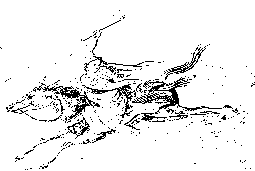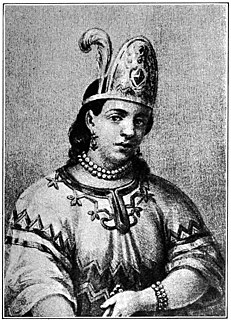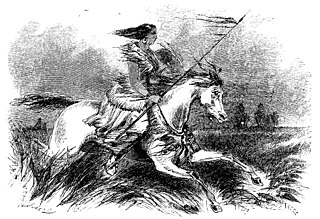 W
WMolly Brant, also known as Mary Brant, Konwatsi'tsiaienni, and Degonwadonti, was influential in New York and Canada in the era of the American Revolution. Living in the Province of New York, she was the consort of Sir William Johnson, the British Superintendent of Indian Affairs, with whom she had eight children. Joseph Brant, who became a Mohawk leader and war chief, was her younger brother.
 W
WBuffalo Calf Road Woman, or Brave Woman, was a Northern Cheyenne woman who saved her wounded warrior brother, Chief Comes in Sight, in the Battle of the Rosebud in 1876. Her rescue helped rally the Cheyenne warriors to win the battle. She fought next to her husband in the Battle of the Little Bighorn that same year. In 2005 Northern Cheyenne storytellers broke more than 100 years of silence about the battle, and they credited Buffalo Calf Road Woman with striking the blow that knocked Lieutenant Colonel George Armstrong Custer off his horse before he died.
 W
WCockacoeskie was a 17th-century leader of the Pamunkey tribe in what is now the American state of Virginia. During her thirty-year reign, she worked within the English system, trying to recapture the former power of past paramount chiefs and maintain peaceful unity among the several tribes under her leadership. She was the first of the tribal leaders to sign the Virginia-Indian Treaty of Middle Plantation.
 W
WDahteste was a Chokonen Apache woman warrior.
 W
WEagle Woman That All Look At was a Lakota activist, diplomat, trader, and translator, who was known for her efforts mediating the conflicts between white settlers, the United States government, and the Sioux. She is credited with being the only woman recognized as a chief among the Sioux.
 W
WPrincess Eréndira of the Purépecha was the princess of the Purépecha from about 1503–1519.
 W
WGouyen, was a 19th-century Apache woman noted for her heroism.
 W
WHanging Cloud was an Ojibwe woman who was a full warrior among her people, and claimed by the Wisconsin Historical Society as the only woman to ever become one. She was the daughter of Chief Nenaa'angebi and his wife Niigi'o. Aazhawigiizhigokwe was of the Makwa-doodem, and was born and lived most of her life at Rice Lake, Wisconsin. Her community became part of the Lac Courte Oreilles Band of Lake Superior Chippewa Indians after the 1854 Treaty of La Pointe.
 W
WMinnie Hollow Wood was a Lakota woman who earned the right to wear a war bonnet because of her valor in combat against the U.S. Cavalry at the Battle of Little Big Horn. At one time, she was the only woman in her tribe entitled to wear a war bonnet.
 W
WMary Jemison (Deh-he-wä-nis) was a Scots-Irish colonial frontierswoman in Pennsylvania and New York, who became known as the "White Woman of the Genesee." She had been taken as a youth and adopted into a Seneca family, assimilating to their culture, marrying two Native American men in succession, and having children with them. In 1824 she published a memoir of her life, a form of captivity narrative. In 1755 during the French and Indian War, Jemison at age 12 was captured with most of her family in a Shawnee mourning raid in what is now Adams County, Pennsylvania. The others of her family were killed. She and an unrelated young boy were adopted by Seneca families. She became fully assimilated, marrying a Delaware (Lenape), and, after his death, a Seneca man. She chose to remain a Seneca rather than return to American colonial culture.
 W
WKuilix, also known as Kuiliy, Mary Quille, and Marie Quilax, was a woman of the Kalispel or Pend d'Oreilles in Montana. She was the leader of a team of warriors who rescued other warriors while fighting the Blackfeet in 1832.
 W
WDonna M. Loring is an author, broadcaster, and Senior Advisor on Tribal Affairs to the Janet Mills, the governor of Maine.
 W
WMarina [maˈɾina] or Malintzin [maˈlintsin], more popularly known as La Malinche [la maˈlintʃe], was a Nahua woman from the Mexican Gulf Coast, who played a key role in the Spanish conquest of the Aztec Empire, acting as an interpreter, advisor, and intermediary for the Spanish conquistador Hernán Cortés. She was one of 20 women slaves given to the Spaniards by the natives of Tabasco in 1519. Later, she gave birth to Cortés's first son, Martín, who is considered one of the first Mestizos.
 W
WNonhelema Hokolesqua Born in 1718 into the Chalakatha (Chilliothe) division of the Shawnee nation and spent her early youth in Pennsylvania. Her brother Cornstalk, and her metis mother Katee accompanied her father Okowellos to the Alabama country in 1725. Their family returned to Pennsylvania within five years. In 1734 she married her first husband, a Chalakatha chief. By 1750 Nonhelema was a Shawnee chieftess during the 18th century and the sister of Cornstalk, with whom she migrated to Ohio and founded neighboring villages.
 W
WLori Ann Piestewa was a United States Army soldier killed during the Iraq War. A member of the Quartermaster Corps, she died in the same Iraqi attack in which fellow soldiers Shoshana Johnson and Jessica Lynch were injured. A member of the Hopi tribe, Piestewa was the first Native American woman to die in combat while serving in the U.S. military and the first woman in the U.S. military killed in the Iraq War. Arizona's Piestewa Peak is named in her honor.
 W
WPretty Nose was an Arapaho woman who participated in the Battle of the Little Bighorn who lived to be at least 101 years old and became a war chief. Her portrait photos by Laton Alton Huffman have been frequently reproduced.
 W
WToby "Winema" Riddle (1848–1920) was a Modoc woman who served as an interpreter in negotiations between the Native American Modoc tribe and the United States Army during the Modoc War. She warned the peace commission of a possible Modoc attack, and she saved the life of the chairman Alfred B. Meacham when the 1873 attack took place.
 W
WMinnie Spotted-Wolf (1923–1988) was the first Native American woman to enlist in the United States Marine Corps.
 W
WNanyehi, known in English as Nancy Ward, was a Beloved Woman and political leader of the Cherokee. She advocated for peaceful coexistence with European Americans and, late in life, spoke out for Cherokee retention of tribal lands. She is credited with the introduction of dairy products to the Cherokee economy.
 W
WBíawacheeitchish, in English Woman Chief, was a bacheeítche (chief) and warrior of the Crow people. Interested in traditionally male pursuits from an early age, she became one of the Crows' most significant leaders, joining the Council of Chiefs as the third ranking member. She attracted substantial attention from Western visitors; she may be the same person as "Pine Leaf" described by James Beckwourth, though the accuracy of this account is challenged.
 W
WXochitl Pronunciation(r. 877-916) was a Toltec Queen and wife of Tecpancaltzin Iztaccaltzin. Her existence beyond legend is questionable, and accounts of her life are mainly based on the writings of indigenous historian Fernando de Alva Ixtlilxochitl.